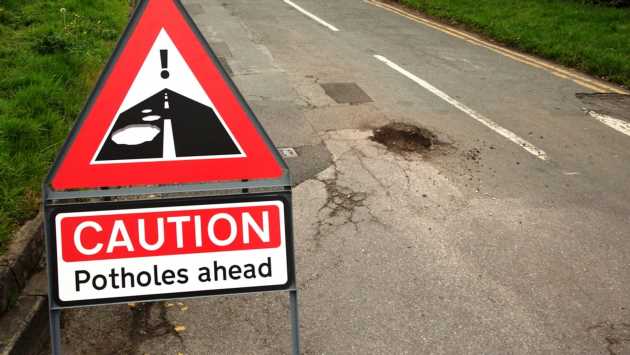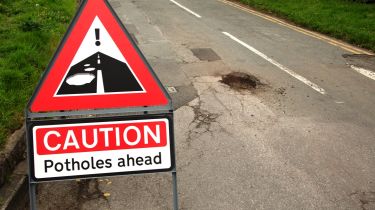Pothole claims: how to report a pothole and claim for damage on your car
Looking to report a pothole, make a claim for pothole damage or both? Our handy guide outlines the process
Potholes, poor road surfaces generally and the damage they can cause to vehicles are an increasing problem for motorists in the UK. Reporting an annoying pothole with a view to getting it fixed is one thing, but if you damage your car as a result of hitting a pothole in the road, the hassle and expense can be significant.
In many cases pothole damage to your car may not be sufficient to make a claim on your insurance worthwhile. However, you can make a claim to be reimbursed for pothole damage by the local council or highway authorities.
Hitting a pothole, even at low speeds, can cause significant damage to your car. They are also a safety hazard to other road users if vehicles are forced to swerve around them, pedestrians trip or cyclists fall off. Local councils point to years of underinvestment in road maintenance and squeezed resources as reasons for cutting spending on essential pothole repair work.
-
DIY car maintenance checklist: how to save money on servicing
In the 12 months to October 2023, the total car damage bill caused by poorly maintained roads amounts to an estimated £16 billion, with £7.5 billion attributed directly to pothole damage – according to a survey carried out by Censuswide for Halfords. Motorists are picking up a hefty proportion of that bill when they are forced to take their car to the garage for pothole damage repairs but most would rather pass the cost on to the people responsible for the potholes in the first place.
Pothole damage – 5 essential steps to making a claim
If you’re looking to make a claim for pothole damage compensation, we’ve outlined the process in five simple steps below.
1. Take notes and photographs at the scene
When it’s safe to do so, pull over and make a note of the exact location of the pothole which has caused damage to your car. Record the size, depth and shape, as well as contact details of any witnesses. Taking pictures of the pothole and any damage on your mobile phone can help support a claim later down the line.
2. Repair the damage to your car
If you need immediate roadside repairs then you can’t do much else but follow the advice of your breakdown service or the garage you’ve called out. If repairs can wait, then it’s worthwhile getting several quotes from different repairers so you can demonstrate as part of any subsequent claim that you’ve acted to achieve the best price. Keep any receipts, invoices or advisory notes as part of your evidence for your claim.
3. Report the pothole
Be a good citizen and do your bit to help make sure fellow motorists don’t fall into the same trap by alerting the council or Highways Agency of the pothole. You can find all the information on the Gov.uk website.
4. Submit your claim
Write a letter to your local council, or fill out the claim form that many now provide, outlining the incident where damage was caused, the extent of the damage, and that you hold the council liable. Be sure to include all photographic evidence, advisory notes and receipts. The council should respond within a couple of weeks, most likely with a Section 58 defence (more on that below) – but you never know, and might be lucky!
5. Decide whether to pursue your claim
If your claim is rejected, you may need to do some investigating to determine whether the council has indeed fulfilled its statutory Section 58 obligations. You are entitled to ask relevant questions about the scheduling and quality of inspections and repairs on the road in question. You must subsequently determine whether you have a realistic case for pursuing your pothole claim.

From then on, it’s down to you to do the detective work to determine whether the council has indeed carried out its inspections and maintenance to the required standard – which generally means in accordance with the Well-Maintained Highways Code of Practice.
This may be time-consuming and difficult, as you’ll probably need to use Freedom of Information requests to determine whether the council has failed in its statutory obligations.
What kind of damage can be caused by potholes?
Potholes and poorly maintained roads can cause significant damage to your vehicle. Depending upon the pothole size, there are four main component groups that are likely to be damaged – suspension, wheels, tyres and steering.
Damage can range from wheel alignment issues, buckled and cracked alloy wheels and broken ball joints, to damaged struts or shock absorbers. Any damage inflicted to these components can affect the car’s handling, it may make the car pull to one side or cause vibration within the cabin or through the steering wheel – as well as knocking or banging noises.
Some damage may not be immediately noticeable. Damage to tyres can be instantly apparent, such as punctures or cuts that can lead to deflation which would need attention on the side of the road. Bulges and cracks in tyres may not be seen straight away but these can weaken the structure of the tyre, increasing the likelihood of a dangerous tyre blowout.
This could have serious consequences for you or other road users, so performing a regular tyre safety check is important to keep you safe and your vehicle roadworthy. Certainly, if you hit a pothole hard but notice no obvious change to the feel of the car, make sure you do a careful visual check of the wheels and tyres when you reach your destination.
Have you ever made a successful or unsuccessful compensation claim for pothole damage to your car? Tell us about it in the comments section below…
Source: Read Full Article



 DIY car maintenance checklist: how to save money on servicing
DIY car maintenance checklist: how to save money on servicing


